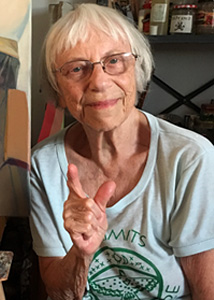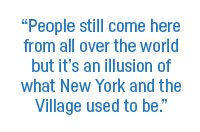 Artist Jenny Tango was born Florence Exler in Brooklyn in 1926. A visual artist working collaboratively and individually in painting, communications media, artist’s books and comic strips, Tango received both a BA and MA from Brooklyn College. With a list of both solo and group exhibitions to her name, Tango lives in Westbeth with her husband, artist Robert Bunkin.
Artist Jenny Tango was born Florence Exler in Brooklyn in 1926. A visual artist working collaboratively and individually in painting, communications media, artist’s books and comic strips, Tango received both a BA and MA from Brooklyn College. With a list of both solo and group exhibitions to her name, Tango lives in Westbeth with her husband, artist Robert Bunkin.
“I had the most wonderful parents in the world,” Jenny Tango confesses. “I now realize they weren’t perfect, but I grew up thinking they were! My father worked in the garment industry and my mother was a housewife, but there was also an artistic aspect in the family. So, I had a cultured background even though we were working class.”
As a young girl, Tango was lucky enough to attend the new High School of Music and Art in New York. “I gravitated towards painting because I like to draw,” she says. “Then at Brooklyn College I ended up in the painting program. That was the time that Abstract Expressionism came out and everybody had to paint like that. You couldn’t do figures! After I graduated I tried Abstract Expressionism for two years and decided it was the most boring thing! So, I went back to figurative painting because there was so much to learn.”
What does Tango like best about painting? “It gives me the opportunity to look,” she replies. “I love looking! Looking to me is an adventure because when you stop and look you discover things. And you never know where it’s going to take you. But looking is different than seeing. Seeing gives you the end results: ‘I see this. I see that.’ Whereas looking is a process of discovery and that’s what makes life so exciting.”
Did Tango face any resistance because of her gender in the art world? “It was difficult being a woman artist back then,” she says. “When I returned to Brooklyn College in 1960 for my masters, I was asked to teach a course in art education. Well, that upset the entire male art department! I guess a woman seemed dangerous. The next year I was given a teaching fellowship and a male classmate received the office fellowship, which was usually given to a woman. However, when we graduated he got a job teaching there and I didn’t!”
For personal reasons, this turned out to be “the best thing” that happened to Tango. “I ended up teaching in high school where I met my husband, Robert. He was a student in my class and we became very close. He was very bright, talented, saw me as a painter and wanted me to go back to it. When I met him, I was happily married with two children. I had to make a very difficult decision but my first husband was wonderful. He understood that if I was going to be an artist, I had to make the break. So, even though there’s a 28-year difference between us, I married Robert. This was during the 60s, an incredible period of creation in the arts. Robert and I were both artists in a world that was bursting with new ideas, and it was just fabulous.”
Interestingly enough, as much as she loved the Village, Tango didn’t move here until 2014. Why did she finally do it? “Because it was a dream I had since I was 16 and first discovered it,” she replies. “And I was determined to do it before I died. Robert and I were living on Staten Island when I put in an application to Westbeth. Well, 24 years went by when I suddenly got this notice that an apartment was available. I said, ‘Are you waiting until you have to bring me there in a box?’ I was 88!”
 “So, we moved to Westbeth,” she continues. “We gave up two floors in a house on Staten Island for an apartment that’s as big as our old kitchen was. We got rid of everything we owned. It’s a small space in which we both paint as well, but we’re so involved in our art that we’re happy.” When asked if she and her husband still get along in such close quarters, Tango laughs. “What keeps us together is art,” she says. “It doesn’t matter where we are.”
“So, we moved to Westbeth,” she continues. “We gave up two floors in a house on Staten Island for an apartment that’s as big as our old kitchen was. We got rid of everything we owned. It’s a small space in which we both paint as well, but we’re so involved in our art that we’re happy.” When asked if she and her husband still get along in such close quarters, Tango laughs. “What keeps us together is art,” she says. “It doesn’t matter where we are.”
The Village of her 16-year-old self, though, is quite different from today. “The art world is going like the Village,” Tango says. “It’s just about money. People still come here from all over the world but it’s an illusion of what New York and the Village used to be. I had to deal with that when I moved here and I’ve come to terms with it. I realize that this isn’t my world anymore, either. It’s a world of young people. But we’ve been through this before and we will be through it again as long as there’s an earth and a human race. We will have our ups and downs. We will be wonderful and we will be bad.”
Photo: Robert Bunkin
